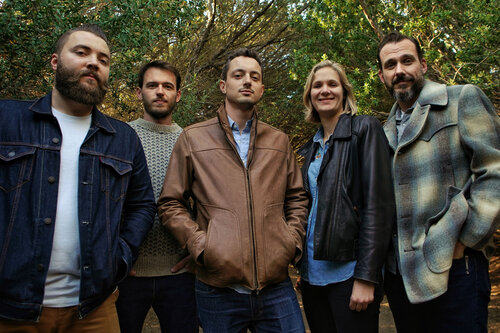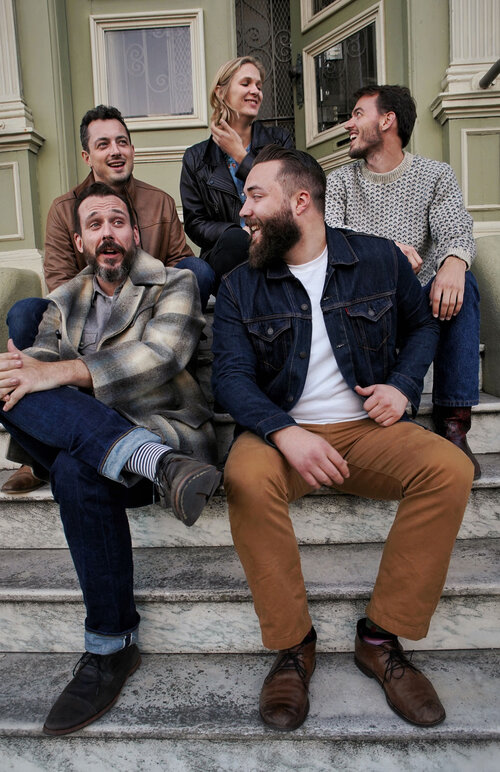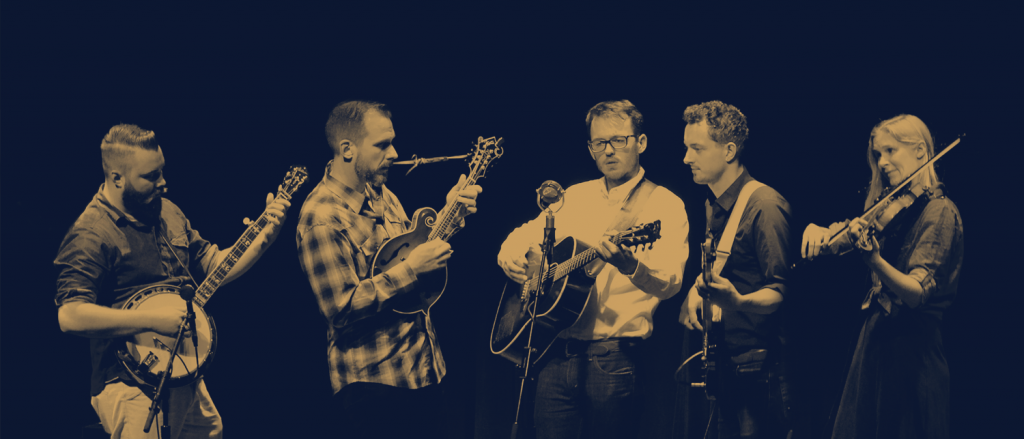The High Water Line: Bluegrass Music and Bluegrass Pride
By Alan Richard

It’s a long way from San Francisco to Mississippi, but singer-songwriter and banjo player Tyler Stegall of The High Water Line has traveled those miles many times physically and spiritually.
That’s what led the 27-year-old musician and his San Francisco Bay-area bandmates to sing about the journey on their new, self-titled debut album.
On the track “North of Jackson,” Stegall writes and sings a story based on the migration of his father, grandparents, and other relatives, who flocked from the Deep South to upstate New York for work—and reflecting the spirit of Stegall’s own unfolding journey as a musician and part of the LGBTQ community:
“The son of a preacher looks upon the field
He thinks to himself of the day he would ride away from Crystal Springs, Mississippi
Going north, far away
He’s leaving the delta, he’s going far away
Gonna do right by himself someday.”
“I was first in my immediate family to be born above the Mason-Dixon Line,” Stegall said. “I have spent probably a ridiculous amount of time, especially when I was young, thinking about Mississippi. I’ve spent a lot of time (there) emotionally.”
The song, co-written with the band’s mandolin player, Tj Carskadon, also charts Stegall’s visits to Mississippi as a child, then leaving behind New York and his conservative upbringing to explore new ideas philosophically, find his own path, and become involved in progressive politics. “I think I had a path to becoming who I am as a person… (that) was radically shaken from what it was,” he said.
The High Water Line includes other originals by Stegall and other band members, along with bluegrass interpretations of several Americana and alt-country songs.
The group also includes fiddler Clare Armenante, guitarist Joel Cofield, and bassist Jim Toggweiler—who has taken the lead in bringing forth old bluegrass and modern alt-country tunes for the band to cover. The group, ranging in age from their late twenties to early forties, shares lead and harmony vocals throughout.

Stegall and Armenante live on the same block in the Sunset District of San Francisco, Carskadon and Toggweiler each live across the bay in Oakland. Cofield now lives in Los Angeles but commutes to the area regularly for the band and work. The High Water Line now has a monthly residency at Club Deluxe in San Francisco, the first Wednesday night of every month.
The bassist, Toggweiler, hadn’t played much bluegrass before joining the group, Stegall said. His plucking adds a rock ‘n roll feel on parts of the new album, not unlike John Cowan’s playing with the legendary bluegrass-rock-fusion group New Grass Revival.
“Everyone has an equal say in decisions we made and the creativity,” he said. “We’re a bluegrass band, but we have a lot of influences from other areas. I don’t think we sat down with any locked-in expectations other than, let’s see how this goes.”
After finishing a degree at the Rochester Institute of Technology, in 2014 Stegall moved from his hometown of Canandaigua, N.Y, to the Bay Area to work in new media interactive design. He also was following his musical muse, which grew into an obsession with bluegrass. He soon made friends in San Francisco’s sizeable bluegrass community, and several of them and Stegall agreed to form a band in 2017.
The High Water Line was born, taking their name from the abundance of water in their surroundings. At first, they chose the name Creek Don’t Rise, but found out that another band in West Virginia had taken that name, Stegall said.
“When I think of The High Water Line, it brings to mind imagery of something continually reaching its highest point,” he said. “We really enjoy making music together in this band, and we’re always trying to raise the bar for ourselves and what we can do.”
Stegall and friends were involved in the California Bluegrass Association, which organizes music festivals across the state, including San Francisco’s annual Father’s Day Bluegrass Festival. Through the statewide group, Stegall learned of Bluegrass Pride, a national grassroots community for the genre’s LGBT musicians and their friends).
In 2017, after submitting an audition CD, The High Water Line was invited to play the prestigious “Vern Stage,” named for Bay Area bluegrass pioneer Vern Williams, at the Father’s Day festival the following year.
Then the group was selected by the California Bluegrass Association to appear on the festival’s main stage in 2019, a major step forward.
“What they saw in us was the work they saw us putting in. We’ve gotten so much love and support,” Stegall said. “The bluegrass world is a very loving one, where you kind of get out of it what you put in.”
The band started recording their first album last year at friend Jon Grier’s studio, Grierlandia.
“The bulk of our recording happened over the course of 3.5 days at his studio,” Stegall said. “You’re kind of almost battling yourself at times, trying not to get in your head, just play and breathe.”
“I can’t wait to do that again with this band,” he said.

A recorded debut
The High Water Line kicks off with a rollicking cover of early country singer Buford Abner’s “Long White Line,” most recently sung by Sturgill Simpson, which works great in this soulful bluegrass translation. Toggweiler sings with a hard-country tilt:
“New York City or St. Joe
Albuquerque, New Mexico…
If somebody wants to know
what’s become of this so-and-so
Well, tell ‘em I’m somewhere looking for the end of that long white line.”
One of the group’s originals, “The Worst Kind of Lonely,” a waltz sung and written by Carskadon that speaks to the wonders of love and risk of heartache, transcending gender and sexuality. The band’s distinctive, lived-in harmonies really show themselves here. “When I hold you and wonder if our love is real, when you’re here in my arms love, I can almost believe … (that) The worst kind of lonely, (is) something I’ll never see…”
The band’s mid-tempo cover of Nashville singer-songwriter Brandy Clark’s “Get High” was the band’s first attempt at a cover that rang true for The High Water Line. “That was the day that it all clicked together,” Stegall said. The song features a nice guitar blues-break by Cofield (whose flatpicking shines on “Get High” and others), as Carskadon sings:
“She sits down at the kitchen table and rolls herself a fat one. … Smoke so sweet fills the air, she maybe ought to crack a window, but all she can do is stare at the paint that’s been peeling off the wall… A couple tokes and her troubles, they don’t seem all that tall…Sometimes the only way to get by is to get high.”
On “North of Jackson,” Stegall slowly sings the storyline at first. Then the tempo doubles and the song really takes off, with Armenante’s exceptional, passionate fiddling standing out here and throughout the album.
“I was thinking about my grandfather one night… (and) had gotten a hold of a great bottle of whiskey,” Stegall said of the song. “I started to experience a lot of personal conflict with a lot of members of my family. That conflict had been a steady presence (and) a constant source of stress for me.”
Now a member of the Bluegrass Pride board of directors, Stegall said the friendships and support he’s found in the organization has helped him blossom as an artist, meeting such talents as Nashville’s Justin Hiltner, who’s also on the group’s board.
The High Water Line plays occasional shows in support of Bluegrass Pride, including a gig opening at Berkeley’s nonprofit club Freight and Salvage for the group Wood and Wire, who was nominated for a Grammy in 2018 for Best Bluegrass Album.
“Roots music should be for everyone. This movement is really something that could help change things” for many young artists, Stegall said.
Ed. Note: This review just happened to be published on Giving Tuesday – and Bluegrass Pride (mentioned above) happens to be doing a big ole fundraising drive today – so if you’re interested in helping support queer bluegrass music and musicians – more details are available here: https://bluegrasspride.net/pages/giving-tuesday